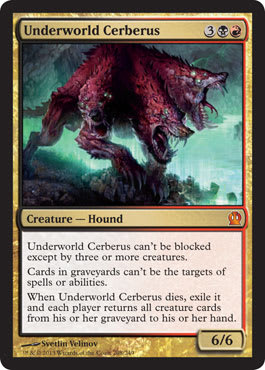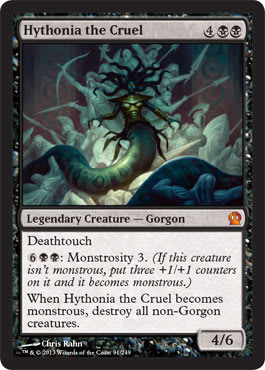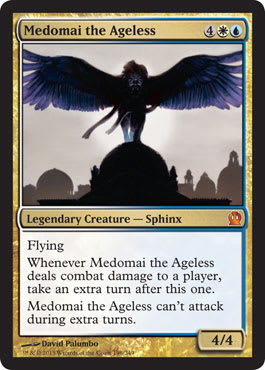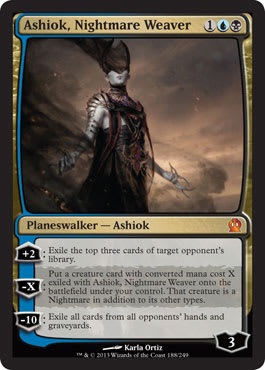For years, players clamored loudly to have a set based around Greco-Roman mythology. Finally, in late 2013 players got their wish with the release of Theros. Not only did the world live up to the excited anticipations of the player base, it exceeded them with a heavy enchantment focus and the popular new devotion mechanic. The set - and block as a whole - were notorious for being a bit on the lower powered side of things. Despite that aspect, though, players loved the flavor of the world and especially the many awesome mythic rares in the set.
As per usual, I'm here to walk you through these mythics and rank them from worst to best. This set features many particularly beloved cards that almost everyone will no doubt recognize, so it's going to be a fun one today! Let's jump in and check them out!
Number Fifteen
In a strictly theoretical sense, Underworld Cerebus reads great from a Standard power level perspective. It's a reasonably large creature that's hard to deal with and also has the secondary impact of shutting down all access to the graveyard. The problem was despite the decent size, no deck wanted this, and the graveyard impact was next to useless in the context of the greater Standard format. Once you got into older formats, this only got worse, with the card being far too expensive to be practical and the decks that would want to cheat it out - namely Reanimator - end up getting shut off by it. A prime example of a card that was unfortunately dead on arrival when it came out.
Number Fourteen
Hythonia also isn't necessarily a bad creature, but it makes for a pretty wretched mythic. Six mana for the mediocre stats followed by a full eight mana to activate its monstrosity effect was just way too high of an investment. To make matters worse, once you use up the monstrosity effect, you're basically just left with a large, non-evasive French vanilla creature. While this one certainly had a little more use than the Cerberus, that wasn't ultimately saying all that much.
Number Thirteen
What makes Medomai such a problem is how fair it is. It's far too difficult to utilize in a meaningful way, so while the core idea of getting to take extra turns is pretty novel, it ends up lacking tremendously in practical usefulness. It's a cool card that people tried like hell to make work but never really got off the ground in any meaningful way, leading to it being cast aside in favor of better cards.
Number Twelve
Unlike the first couple cards here, Heliod is actually fantastic. All five of the gods in this set are masterful designs that each play wonderfully. It just so happens that Heliod is arguably the worst of the bunch. I'll get to why it's arguable on the next card, but the big mark against him is he just never saw much competitive play outside of a small handful of decks in Standard. He's fine in Commander, but there's much better ways to both give mass vigilance (such as Brave the Sands) and various other token makers. A great card to be sure, but low among the myriad of awesome mythics in this set.
Number Eleven
In some ways, I'd actually argue that Heliod is better than Nylea. Nylea requires you to have other creatures to utilize effectively, but Heliod just makes them himself. I have to give Nylea the higher placement on this list, though, for one simple reason: she saw far more competitive play than Heliod ever did. Mono-Green Devotion was one of the best decks of this era, and Nylea provided the deck with a way to utilize Nykthos, Shrine to Nyx mana in order to close games out with your powerful creatures. On her own, she may be a bit mediocre, but in the right context, she's an utter house.
Number Ten
Once upon a time, Angel of Despair was a fairly popular tournament staple during the era of the original Ravnica block. While the card largely fell out of favor afterwards, it still showed up here and there in Commander as well as in Legacy Reanimator decks to deal with Sneak and Show decks and Karakas. Then Theros came along and brought us Ashen Rider, and anyone who was playing Angel of Despair anywhere quickly swapped it out for this card. Ashen Rider never really reached the highs that some people felt it was destined for, but it carved out a really niche role and did it extremely well.
Number Nine
Mono-Black Devotion was arguably the best deck of the era and Erebos, God of the Dead saw a respectable amount of play there. You only wanted it in small numbers because there's only so many times you could utilize the card draw ability, but when you could make use of it, it was devastating. The card continued to see play well into the Theros-Khans Standard format in all kinds of decks utilizing Black mana, and was as noteworthy of a role player as you could get in the era. To this day, the card continues to be tremendously popular in both Commander and Cube for its overall utility.
Number Eight
Putting Master of Waves right in the middle of this list almost feels wrong, but the more I look at the list as a greater whole the more this placing feels right. The card hasn't seen much showing beyond its Standard era, but in that time it was one of the defining pieces of the entire format. This was owing to the fact that it was the critical finishing move for the Mono-Blue Devotion deck that was one of the best things you could do in the format.
Number Seven
I initially had this card below Master of Waves, but what I realized is just how much wider the appeal was on this one. Xenagos not only was a huge player in Standard thanks to its utility in the Gruul Monsters decks of the time, but it also showed up in a variety of other formats as well. It had massive appeal in both Cube and Commander, and even has seen competitive play as recently as Pioneer in the last year or so in Gruul Vehicles lists. It may not be quite as well remembered as many of the set's other high points, but it's a fantastic multipurpose card nevertheless.
Number Six
Wizards continued their annual early previews for the upcoming fall set by including Polukranos in the Duel Decks: Heroes vs. Monsters product. The card was quickly seen as being fairly strong, but no one could know just how strong it would be until Theros finally landed. With Mono-Green Devotion becoming one of the format's best decks and Nykthos, Shrine to Nyx enabling wild amounts of mana access, Polukranos became a monstrous force to be reckoned with. The card dominated as a mighty top-end finisher for the deck and was so good it was a part of the famous undervaluation of Siege Rhino, with a Redditor stating it "might see play when Polukranos rotates."
Number Five
During his tenure in Standard, Purphoros had a rather modest showing, occasionally appearing in aggro decks in small numbers to act as a powerful closer in certain matchups. Where the card truly shined was in Commander, where his ability to damage not one player but all of them at once was immediately noted as being incredibly powerful - particularly when you could generate tons of tokens. As Commander has continued to grow in popularity, Purphoros' stock has only gone up, with Wizards going so far as to print a judge promo for him in 2022.
Number Four
Few cards are as agonizingly painful to deal with as Ashiok, Nightmare Weaver. The card showed up a ton in Standard Esper lists as ways to stop opponents from accessing their best cards via milling while simultaneously using them against them. Not only was the card powerful there, but it became a surprisingly massive hit in Cube, where it was arguably one of the most potent things you could be doing in the MTGO Vintage Cube for some time.
Number Three
If Master of Waves was the key finisher for Mono-Blue Devotion, Thassa was the glue that held it all together. Thassa not only set up your draws expertly, she also made your creatures difficult to block and then eventually turned into a massive beater in her own right. She was a massive presence the entire time she was in Standard and even beyond that format, she continues to be a huge card for both Cube and Commander alike. The best of the original five gods by a mile and a fan favorite to this day.
Number Two
If ever there was a card where you really needed the context behind it to understand it, Stormbreath Dragon is an easy contender. Looking at it today, this is little more than a french vanilla dragon that doesn't do a whole ton. When you look at the context of the Standard format that it was played in, however, it was one of the most powerful and dominant cards around. It was big enough to have an immediate impact on any game it was played in and the myriad methods of ramping throughout the format ensured it got down in a fairly quick manner. That impact was even bigger if you could activate its monstrosity ability to deal an even bigger hit.
Number One
If you played Standard in the Theros era, you learned to fear the control decks closing out the game on the back of Elspeth, Sun's Champion. She just did it all. Too many big creatures on the board? Wipe it out. A couple small creatures floating around? Make a bunch of tokens and block them. Ready to close out the game? Get an emblem and demolish your opponent with your army of tokens. Elspeth was a massive player of her era, is still an absolute staple of Commander and Cube now, and has been firmly cemented in history as one of the best planeswalkers of all time. Top prize couldn't go to anyone but the champ.
Paige Smith
Twitter: @TheMaverickGal
Twitch: twitch.tv/themaverickgirl
YouTube: TheMaverickGal






































